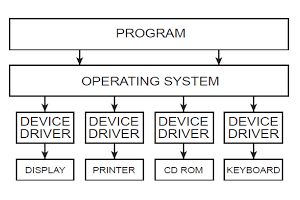What are Device Drivers?
To understand device drivers, we need to know about devices in the context of personal computers.
Your PC can have lots of devices connected to it. These may be devices that are:
- connected permanently because they’re built into the machine; these devices can include hard disk drives, CD-ROM and DVD drives, network cards, and sound cards
- normally connected to the PC, such as printers, scanners, and mouse/keyboard/webcams that are usually switched on when the machine is running
- plugged in occasionally to transfer data, such as digital cameras, tablets, mobile phones, and MP3 players.
A device driver, sometimes also known as a PC driver, is a means of communication between the PC and a particular device.
Why Drivers are Needed
It is possible to connect a huge range of devices to a PC – any number of printers, storage devices, and communications equipment. Each of these devices has different requirements and characteristics while your PC’s operating system may also vary, with separate versions of Windows, Linux, and the Mac operating system having different ways of working and a whole range of commands.
The problem is that all the various operating systems need to be able to talk to each device, or at least most of them so that they can be used on the PC. They need to issue requests and receive responses so that everything works. But with so many variations, with literally thousands of devices being available, the permutations and combinations are impossibly high.
The answer to the problem is a device driver, which is developed for a specific device and has versions for the various editions of operating systems. The purpose of the device or PC driver is to serve as a bridge between the PC and a device, interpreting requests from the operating system and passing them to the device, then handling responses from devices in the opposite direction. As a result, the operating system can issue generic commands and receive generic responses, without needing to know or care about the specific device to which it is connected. The operating system only needs to know that is it a laser printer, hard disk or whatever, and can issue high level commands accordingly. The device driver simplifies the whole process.
How Drivers Work
Most computer processing is concerned with handling data and, depending on the type and use of the data, there are different programs to deal with it. Word processors cover letters and documents, spreadsheets handle data in tabular form, there are drawing applications, video editing products and all kinds of software.
Each of these programs will generally need to communicate with devices, reading data from a disk and outputting a report to a printer, for example. All communications go via the computer’s operating system and device drivers are used to interpret the command so that the device can understand it.
If a database program wants to output a report, it will send the data and print command to the appropriate printer via the operating system. Since the printer has device drivers loaded, the operating system only needs to issue a high level command to the printer without bothering about what type of printer it actually is. The device driver will interpret this command, breaking it down into low level commands that are specific to the printer, before passing them on.
When the printer or other device receives the commands, because they have been interpreted and translated by the device driver, it understands them and can act accordingly. Once the command is successfully completed, or if there are problems, a suitable response is sent back. This response is picked up by the device driver and again interpreted by it, this time converting it from a device-specific command into a high level command that is passed to the operating system and then to the program so that the outcome is known.
Much computer processing involves a whole series of commands and responses being passed backwards and forwards. Each one is picked up and translated by the appropriate device driver so that it is meaningful to the recipient. Device drivers, therefore, have a vital role to play in the smooth operation of a PC.
![]() Got Outdated Drivers?
Got Outdated Drivers?
CLICK HERE to Automatically Update and Maintain Your Drivers!
Entry Filed under: Device Drivers



Leave a Comment
Trackback this post | Subscribe to the comments via RSS Feed